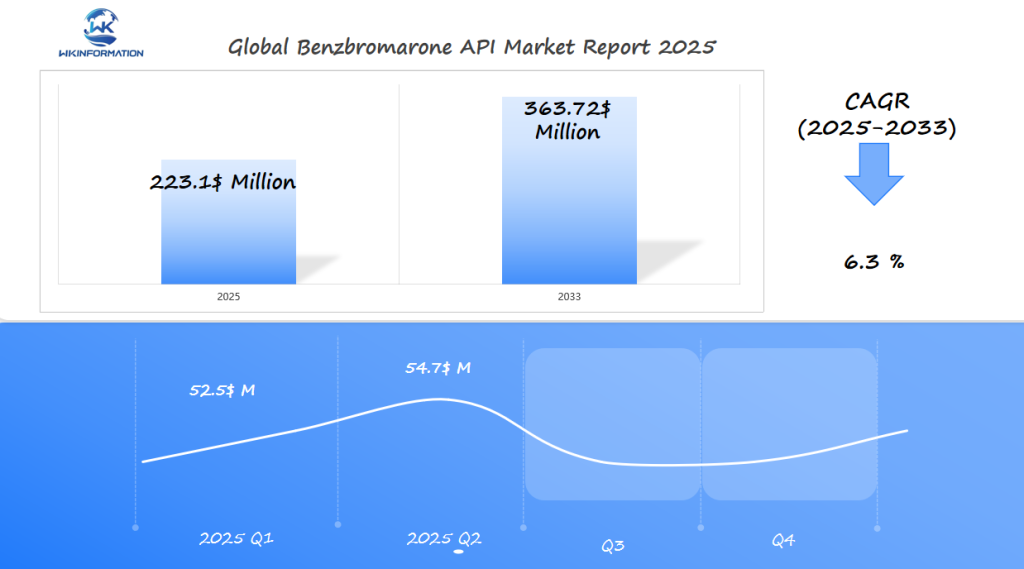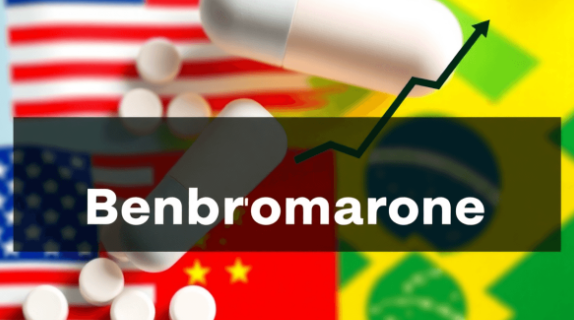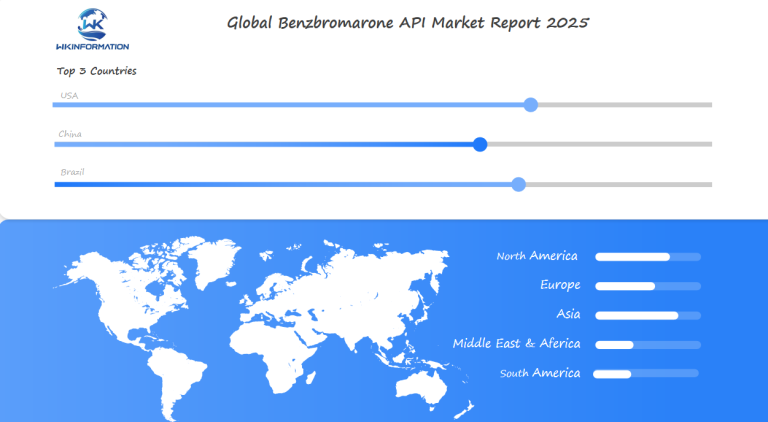Benzbromarone API Market in 2025 with $223.1 Million Insights and Key Developments from the US, China, and Brazil
Explore how US, China, and Brazil will dominate the Benzbromarone API market by 2025 under Trump’s economic policies.
- Last Updated:
Benzbromarone API Market Forecast for Q1 and Q2 of 2025
The Benzbromarone API market was valued at approximately USD 223.1 million in 2025, growing at a CAGR of 6.3% from 2025 to 2033. In Q1 2025, the market is expected to generate around USD 52.5 million, driven by growing demand for uric acid-lowering drugs in the treatment of gout and other hyperuricemia-related conditions. By Q2 2025, the market is projected to reach approximately USD 54.7 million, as healthcare systems in emerging markets like China and Brazil begin to expand their pharmaceutical capabilities.
The US, China, and Brazil are crucial to the growth of this market. The US is the leading market due to its high healthcare expenditure and the increasing prevalence of gout among the aging population. China, with its expanding pharmaceutical industry, has a growing demand for affordable treatment options for chronic conditions like gout. Brazil’s large and evolving healthcare system provides a significant opportunity for market growth, particularly in the treatment of metabolic disorders

Understanding the Benzbromarone API Market: Supply Chain Dynamics
The supply chain dynamics of the Benzbromarone API market involve a complex network that includes everything from sourcing raw materials to distributing the product to end-users. This supply chain is crucial for ensuring that Benzbromarone, an important medication for gout and hyperuricemia, is both available and of high quality.
Key Players in Upstream Production Processes
The upstream production processes of the Benzbromarone API market involve several key players:
- Raw Material Suppliers: These suppliers provide the essential chemical components needed for the synthesis of Benzbromarone.
- Manufacturers: Leading pharmaceutical companies and specialized contract manufacturers are responsible for synthesizing, testing, and refining Benzbromarone APIs.
- Regulatory Agencies: These agencies oversee compliance with safety standards and facilitate market entry by granting approvals.
Distribution Channels Influencing Market Accessibility
Once produced, Benzbromarone needs to be distributed efficiently to healthcare providers. Several distribution channels play a role in ensuring this accessibility:
- Pharmaceutical Wholesalers: These intermediaries act as a link between manufacturers and healthcare facilities.
- Direct-to-Clinic Models: Streamlined processes that allow direct supply to hospitals and clinics.
- Online Pharmacies: Expanding reach and convenience for end-users, particularly in regions where local availability is limited.
By understanding these dynamics, stakeholders can navigate challenges and seize opportunities within this critical pharmaceutical segment.
Key Trends Shaping the Benzbromarone API Market in 2025
The Benzbromarone API market is experiencing several significant market trends that are expected to influence its growth trajectory by 2025. These trends revolve around evolving drug approval processes, cutting-edge healthcare innovations, and advancements in formulation and delivery methods.
1. Current Trends
Increasing demand for effective treatments of gout and hyperuricemia is driving the market forward. As patients seek safer alternatives with fewer side effects, Benzbromarone’s reintroduction in major markets like the United States reflects a growing trust in its therapeutic efficacy.
2. Impact of Drug Approvals
New drug approvals are crucial in shaping market dynamics. In China, the surge in generic drug approvals, including Benzbromarone, has opened up competitive landscapes by enhancing accessibility and driving down costs. This trend is instrumental in fostering an environment where both established brands and new entrants can thrive.
3. Innovations in Formulation and Delivery
The pharmaceutical industry is witnessing a wave of innovations aimed at optimizing drug formulations and delivery methods. Companies are investing in research to develop novel formulations that enhance bioavailability and patient compliance. Such advancements not only improve therapeutic outcomes but also expand market reach by catering to diverse patient needs. For instance, recent research highlights the potential of new strategies that could further revolutionize the way Benzbromarone is formulated and delivered.
These trends collectively paint a promising picture for the Benzbromarone API market, positioning it as a dynamic sector poised for substantial growth.
Tackling Restrictions and Challenges in the Benzbromarone API Market
Navigating the Benzbromarone API market presents several challenges, primarily due to stringent regulatory hurdles. Manufacturers must adhere to various compliance standards, which differ across regions. These regulations aim to ensure safety and efficacy but often complicate market entry with extensive documentation and approval timelines.
Safety concerns have historically impacted the reputation of Benzbromarone. Initially withdrawn from some markets due to adverse effects, these concerns still resonate today. The challenge lies in restoring confidence among healthcare providers and patients by demonstrating improved safety profiles through rigorous clinical trials and transparent reporting.
Breaking into new markets requires overcoming significant market entry barriers. Key strategies include:
- Adapting formulations: Tailoring drug formulations to meet specific regional needs can provide a competitive edge.
- Building partnerships: Collaborating with local pharmaceutical companies or distributors can enhance market penetration.
- Investing in research: Continuous investment in R&D is crucial for staying ahead of regulatory changes and improving drug safety.
By addressing these challenges head-on, manufacturers can position themselves strategically within the Benzbromarone API market, ensuring sustainable growth and market presence.

Impact of Geopolitical Factors on Benzbromarone API Distribution
Geopolitical influences significantly impact the distribution networks of Benzbromarone APIs, as trade policies between countries dictate how pharmaceutical products are exchanged globally. Trade agreements and tariffs can either facilitate or hinder the flow of Benzbromarone APIs across borders. For instance, favorable trade policies may lead to lower costs and easier access for pharmaceutical companies looking to penetrate international markets, while restrictive tariffs can increase costs and limit availability.
Geopolitical stability plays a crucial role in shaping pharmaceutical markets worldwide. In regions where political unrest is prevalent, the supply chain for Benzbromarone APIs may face disruptions. These interruptions can result from logistical challenges, regulatory changes, or shifts in government priorities that affect pharmaceutical imports and exports.
International collaborations and alliances can enhance market access by creating stable trading environments.
Conversely, volatile geopolitical climates may deter investment and slow down the approval processes for new drug formulations.
Understanding the intricate web of geopolitical dynamics is essential for stakeholders in the Benzbromarone API market. Navigating these complexities requires strategic planning and adaptability to maintain consistent distribution channels amid an ever-changing global landscape.
Segmenting the Benzbromarone API Market by Type and Therapeutic Application
Product Segmentation within the Benzbromarone API market is crucial for understanding its diverse landscape. The market offers various formulation types, each designed to meet specific therapeutic needs. These formulations primarily include tablets, capsules, and liquid suspensions, catering to different patient preferences and absorption rates.
The therapeutic applications of Benzbromarone are centered around its efficacy in treating conditions like gout and hyperuricemia. As a potent uricosuric agent, Benzbromarone enhances the excretion of uric acid through the kidneys, reducing serum urate levels effectively. This makes it an essential option for patients who cannot tolerate or do not respond adequately to first-line treatments such as allopurinol.
Different Formulations of Benzbromarone
The following are the different formulations of Benzbromarone:
- Tablets: These are the most common form due to their convenience and ease of use. They are typically prescribed for long-term management of chronic conditions.
- Capsules: Similar to tablets in terms of usage, capsules offer an alternative for patients who may have difficulty swallowing pills.
- Liquid Suspensions: This formulation is particularly beneficial for pediatric or geriatric patients who may have difficulty swallowing pills.
Therapeutic Applications of Benzbromarone
Benzbromarone is primarily used in the treatment of:
- Gout: A type of arthritis characterized by sudden and severe pain, redness, and swelling in joints caused by elevated levels of uric acid.
- Hyperuricemia: An excess amount of uric acid in the blood, which can lead to gout attacks or kidney stones if left untreated.
The demand for these varied formulations continues to grow, driven by the need for more personalized treatment options that can address specific patient requirements while managing side effects effectively. Each product type plays a distinct role in meeting the therapeutic demands of diverse patient populations globally.
Global Insights into the Benzbromarone API Market: A Comparative Analysis Between Key Regions (US, China, Brazil)
Global Market Overview
The Benzbromarone API market is experiencing strong growth due to increasing demand worldwide. It is expected to reach a size of $223.1 million by 2025, highlighting the drug’s importance in treating gout and hyperuricemia. This growth is heavily influenced by regional factors in major markets such as the United States, China, and Brazil.
Regional Analysis
United States
After its reintroduction, Benzbromarone has started to regain popularity. The US market benefits from advanced healthcare infrastructure and a focus on innovative treatment options that effectively manage uric acid levels. However, past safety concerns continue to shape regulatory scrutiny and market acceptance.
China
China’s pharmaceutical industry is known for its quick approval of generic drugs, which leads to competitive pricing and greater accessibility. The country’s push for local manufacturing of generics, including Benzbromarone, supports this trend. As a result, distribution networks are expanding and patients have better access to medication.
Brazil
In Brazil, significant investments in research and development are improving the production capabilities for APIs like Benzbromarone. Government initiatives that promote local manufacturing are reducing reliance on imports and improving healthcare outcomes. This strategic focus on self-sufficiency positions Brazil as an important player in the regional market.
Each region plays a unique role in shaping the global dynamics of the Benzbromarone API market, creating both opportunities and challenges for the industry as it continues to grow.

US Market Growth for Benzbromarone API
The U.S. market for Benzbromarone API has seen steady growth due to increasing cases of gout and hyperuricemia. Although Benzbromarone is not FDA-approved due to concerns about hepatotoxicity, there is growing interest in alternative uricosuric drugs. The demand for API manufacturing has been driven by research initiatives and the potential for regulatory reconsideration. Additionally, the rising prevalence of lifestyle-related conditions, such as obesity and metabolic syndrome, has fueled the need for effective gout treatments.
Opportunities in China’s Benzbromarone API Market
China has emerged as a leading producer of Benzbromarone API due to its cost-effective manufacturing and well-established pharmaceutical supply chain. The country offers significant opportunities for API producers, especially with the increasing domestic demand for gout treatment. Government initiatives to support pharmaceutical exports and ongoing research in innovative formulations have further bolstered the market. Additionally, Chinese companies are actively pursuing global partnerships, aiming to expand their footprint in international markets.
Brazil's Contribution to the Benzbromarone API Market
Brazil plays a key role in the Benzbromarone API market, particularly in Latin America, where gout prevalence is rising. The country has approved Benzbromarone for clinical use, making it a vital market for both local and international API suppliers. Brazilian pharmaceutical companies have been expanding their production capacity to meet growing demand, while government healthcare programs have facilitated access to cost-effective treatments. The increasing awareness of gout management and strategic trade agreements have further contributed to market expansion.
Looking Ahead: The Future Trajectory And Competitive Forces In The Benzbromarone API Industry Beyond 2025
Future Projections and Emerging Markets
The Benzbromarone API industry is expected to witness significant growth beyond 2025, driven by emerging markets such as Africa and India. These regions are poised to impact global dynamics due to increasing healthcare demands and the expansion of pharmaceutical infrastructure. The rising prevalence of gout and hyperuricemia in these areas fuels this demand, opening new avenues for market players.
- Africa is focusing on improving access to essential medications, creating opportunities for local production and distribution.
- India continues to strengthen its position as a major hub for pharmaceutical manufacturing, leveraging its cost-effective production capabilities.
Competitive Forces Analysis
Understanding the competitive landscape is crucial for stakeholders aiming to capitalize on market opportunities. Key players in the Benzbromarone API market are strategically positioning themselves through:
- Innovation in Formulation: Companies are investing in R&D to develop advanced formulations that enhance efficacy and patient compliance.
- Strategic Alliances: Collaborations and partnerships with local firms in emerging markets are being prioritized to expand reach and influence.
- Regulatory Navigation: Firms adept at navigating complex regulatory environments will gain a competitive advantage, particularly in regions with stringent approval processes.
These dynamics highlight the strategic maneuvers necessary for securing a stronghold in the evolving Benzbromarone API landscape.
Competitive Forces in the Benzbromarone API Industry
-
Torrent Pharmaceuticals Ltd. – India
-
Samil Pharmaceutical Co., Ltd. – South Korea
-
Active Pharmaceutical Ingredients (API) Inc. – (Country varies; specify the exact company if needed)
-
Cipla Ltd. – India
-
Menarini Group – Italy
-
Almac Group – United Kingdom
-
Stride Pharma Science Pvt. Ltd. – India
-
Eurofarma Laboratórios S.A. – Brazil
-
CKD Pharmaceuticals (Chong Kun Dang Pharmaceutical Corp.) – South Korea
-
Zhejiang Huahai Pharmaceutical Co., Ltd. – China
Overall
| Report Metric | Details |
|---|---|
| Report Name | Global Benzbromarone API Market Report |
| Base Year | 2024 |
| Segment by Type |
·0.98 |
| Segment by Application |
·Tablets |
| Geographies Covered | · North America (United States, Canada)
· Europe (Germany, France, UK, Italy, Russia) · Asia-Pacific (China, Japan, South Korea, Taiwan) · Southeast Asia (India) · Latin America (Mexico, Brazil) |
| Forecast units | USD million in value |
| Report coverage | Revenue and volume forecast, company share, competitive landscape, growth factors and trends |
Key regions such as the United States, China, and Brazil are driving this growth through strategic developments in generic approvals, local manufacturing capabilities, and addressing safety concerns. Their combined efforts foster innovation and enhance accessibility to treatments.
Looking ahead, understanding the competitive dynamics and emerging markets will be crucial for stakeholders aiming to capitalize on these opportunities. Continuous monitoring of regulatory landscapes and geopolitical influences will also play a significant role.
For those seeking deeper insights into the market’s future, the complete Wkinformation Research report offers detailed analysis and comprehensive data. Engage with this resource to navigate the complexities of the Benzbromarone API industry effectively.
Global Benzbromarone API Market Report (Can Read by Free sample) – Table of Contents
Chapter 1: Benzbromarone API Market Analysis Overview
- Competitive Forces Analysis (Porter’s Five Forces)
- Strategic Growth Assessment (Ansoff Matrix)
- Industry Value Chain Insights
- Regional Trends and Key Market Drivers
- Benzbromarone APIMarket Segmentation Overview
Chapter 2: Competitive Landscape
- Global Benzbromarone APIplayers and Regional Insights
- Key Players and Market Share Analysis
- Sales Trends of Leading Companies
- Year-on-Year Performance Insights
- Competitive Strategies and Market Positioning
- Key Differentiators and Strategic Moves
Chapter 3: Benzbromarone API Market Segmentation Analysis
- Key Data and Visual Insights
- Trends, Growth Rates, and Drivers
- Segment Dynamics and Insights
- Detailed Market Analysis by Segment
Chapter 4: Regional Market Performance
- Consumer Trends by Region
- Historical Data and Growth Forecasts
- Regional Growth Factors
- Economic, Demographic, and Technological Impacts
- Challenges and Opportunities in Key Regions
- Regional Trends and Market Shifts
- Key Cities and High-Demand Areas
Chapter 5: Benzbromarone API Emerging and Untapped Markets
- Growth Potential in Secondary Regions
- Trends, Challenges, and Opportunities
Chapter 6: Product and Application Segmentation
- Product Types and Innovation Trends
- Application-Based Market Insights
Chapter 7: Benzbromarone API Consumer Insights
- Demographics and Buying Behaviors
- Target Audience Profiles
Chapter 8: Key Findings and Recommendations
- Summary ofBenzbromarone API Market Insights
- Actionable Recommendations for Stakeholders

Access the study in MULTIPLEFORMATS
Didn’t find what you’re looking for?
TALK TO OUR ANALYST TEAM
Need something within your budget?
NO WORRIES! WE GOT YOU COVERED!
Call us on: +1-866-739-3133
Email: infor@wkinformation.com
What is the significance of the Benzbromarone API market in treating gout and hyperuricemia?
The Benzbromarone API market plays a crucial role in treating gout and hyperuricemia by providing effective medications that lower uric acid levels in the blood, thereby alleviating symptoms and preventing gout attacks.
What are the projected market size estimates for the Benzbromarone API market by 2025?
Market size projections for the Benzbromarone API market indicate significant growth by 2025, driven by increasing demand for gout treatments and advancements in drug formulations.
What are the key trends shaping the Benzbromarone API market for 2025?
Key trends influencing the Benzbromarone API market in 2025 include new drug approvals, innovations in formulation and delivery methods, and an overall increase in healthcare innovations aimed at improving patient outcomes.
What challenges do manufacturers face in the Benzbromarone API market?
Manufacturers of Benzbromarone APIs encounter several challenges including regulatory hurdles, safety concerns affecting market confidence, and barriers to entry in various international markets.
How do geopolitical factors impact the distribution of Benzbromarone APIs?
Geopolitical factors such as trade policies and stability significantly affect the distribution networks for Benzbromarone APIs, influencing how these products are accessed in different international markets.
Which regions are leading in the global Benzbromarone API market, particularly between the US, China, and Brazil?
A comparative analysis of key regions reveals that the US, China, and Brazil each have unique dynamics within the global Benzbromarone API market, with varying trends and growth potentials that shape their respective pharmaceutical landscapes.


